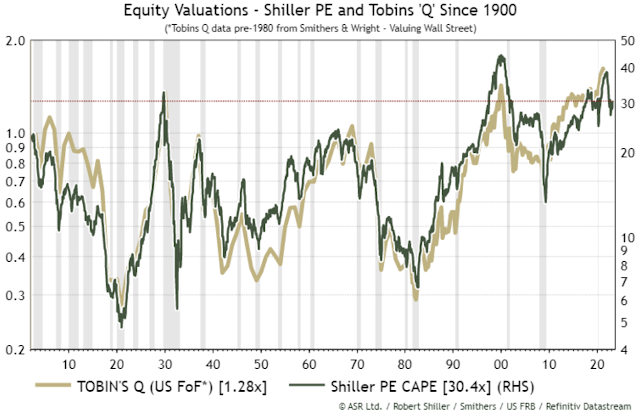*** denotes well-worth reading in full at source (even if excerpted extensively here)
Economic and Market Fare:
- Nominal activity has decelerated, with real growth contracting and inflation decelerating. These moves aligned with our expectations and reflected the slowing of the labor impulse to broader activity.
- Alongside this contraction in real activity, we saw significant stress in the banking system as the cumulative impact of tightening policy liquidity flowed through to financial intermediaries. We are now moving into the part of the cycle where public and private sector liquidity are likely to contract in unison. This path bodes ill for future nominal activity.
- Our systems have now confirmed recessionary conditions. We see equity markets as particularly exposed to this risk, which our cycle strategies will look to exploit.
- The explosion of volatility in the short-end implies a much broader distribution of outcomes for rates at year-end than only a month or two ago.
- This translates to a wide band of risks around our modal forecast, which sees the hiking cycle ending at 5.25% in May, recession in H2 2023 and rate cuts beginning in Q1 2024.
- Such high implied volatility suggests ‘fat tails’ in either direction relative to the year-end forward curve, but the bigger risk is to lower yields, we think
Quotes of the Week:
Alf: True, the market is pricing more Fed cuts in the next 12 months (~150 bps) than it has ever done in recent history. Even more cuts priced in than Dec 2000 or 2007. But as a reminder, in 2001 and 2008 the Fed DID end up cutting rates by over 400 (!) bps.
Charts:
1:
...Anyone notice that loan demand fell off a cliff before the Bank Crisis.
— James E. Thorne (@DrJStrategy) April 5, 2023
High rates effects demand. Secular stagnation and deflation on its way ..
If the Fed not careful .. interest rates going back to the zero bound.
Don’t be surprised when it happens.
Fed needs to cut. pic.twitter.com/9MU320F7E4
...Inflation Expectations Y-o-Y
— Mike "Mish" Shedlock (@MishGEA) April 4, 2023
If inflation expectations mattered, this chart would not exist.
From 2013 to 2021 inflation expectations averaged well over three percent. Even with the Fed pumping hard with QE, the Fed could not get measured inflation over two percent! pic.twitter.com/FtqyzPXVBV
ISM PMI is hugely important - it's used to forecast all kinds of stuff.
— Sergei Perfiliev 🇺🇦 (@perfiliev) April 3, 2023
For example, PMI tends to lead corporate earnings growth by about a year.
Below, we shifted the PMI index forward by 12 months and plotted it against SPX trailing 12-months EPS growth.
Based on this… pic.twitter.com/rMl34KNsOt
(not just) for the ESG crowd:




















No comments:
Post a Comment